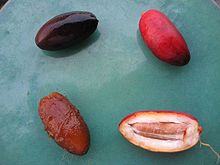The fruit's English name (through Old French), as well as the Latin species name dactylifera, both come from the Greek word for "finger," dáktulos, because of the fruit's elongated shape. Dates are oval-cylindrical, 3–7 cm long, and 2–3 cm diameter, and when ripe, range from bright red to bright yellow in colour, depending on variety. Dates contain a single stone about 2–2.5 cm long and 6–8 mm thick. Three main cultivar groups of date exist: soft (e.g. 'Barhee', 'Halawy', 'Khadrawy', 'Medjool'), semi-dry (e.g. 'Dayri', 'Deglet Noor', 'Zahdi'), and dry (e.g. 'Thoory'). The type of fruit depends on the glucose, fructose and sucrose content.
The date palm is dioecious, having separate male and female plants. They can be easily grown from seed, but only 50% of seedlings will be female and hence fruit bearing, and dates from seedling plants are often smaller and of poorer quality. Most commercial plantations thus use cuttings of heavily cropping cultivars. Plants grown from cuttings will fruit 2–3 years earlier than seedling plants.
Dates are naturally wind pollinated but in both traditional oasis horticulture and in the modern commercial orchards they are entirely pollinated manually. Natural pollination occurs with about an equal number of male and female plants. However, with assistance, one male can pollinate up to 100 females. Since the males are of value only as pollinators, this allows the growers to use their resources for many more fruit producing female plants. Some growers do not even maintain any male plants as male flowers become available at local markets at pollination time. Manual pollination is done by skilled labourers on ladders. In some areas such as Iraq the pollinator climbs the tree using a special climbing tool that wraps around the tree trunk and the climber's back to keep him attached to the trunk while climbing. Less often the pollen may be blown onto the female flowers by a wind machine.
Fresh dates, clockwise from top right: crunchy, crunchy opened, soft out of skin, soft.
Parthenocarpic cultivars are available but the seedless fruit is smaller and of lower quality.[citation needed]
Dates ripen in four stages, which are known throughout the world by their Arabic names kimri (unripe), khlal (full-size, crunchy), rutab (ripe, soft), tamar (ripe, sun-dried).
Dates are an important traditional crop in Iraq, Arabia, and north Africa west to Morocco and are mentioned more than 50 times in the Bible. In Islamic culture, dates and yogurt or milk are traditionally the first foods consumed for Iftar after the sun has set during Ramadan. Dates (especially Medjool and Deglet Noor) are also cultivated in America in southern California, Arizona and southern Florida in the United States and in Sonora and Baja California in Mexico.
Date palms can take 4 to 8 years after planting before they will bear fruit, and produce viable yields for commercial harvest between 7 to 10 years. Mature date palms can produce 80–120 kilograms (176–264 lb) of dates per harvest season, although they do not all ripen at the same time so several harvests are required. In order to get fruit of marketable quality, the bunches of dates must be thinned and bagged or covered before ripening so that the remaining fruits grow larger and are protected from weather and pests such as birds.
- Wikipedia








